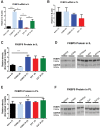Dynamic expression of FKBP5 in the medial prefrontal cortex regulates resiliency to conditioned fear
- PMID: 28298552
- PMCID: PMC5362697
- DOI: 10.1101/lm.043000.116
Dynamic expression of FKBP5 in the medial prefrontal cortex regulates resiliency to conditioned fear
Abstract
The factors influencing resiliency to the development of post-traumatic stress disorder (PTSD) remain to be elucidated. Clinical studies associate PTSD with polymorphisms of the FK506 binding protein 5 (FKBP5). However, it is unclear whether changes in FKBP5 expression alone could produce resiliency or susceptibility to PTSD-like symptoms. In this study, we used rats as an animal model to examine whether FKBP5 in the infralimbic (IL) or prelimbic (PL) medial prefrontal cortex regulates fear conditioning or extinction. First, we examined FKBP5 expression in IL and PL during fear conditioning or extinction. In contrast to the stable expression of FKBP5 seen in PL, FKBP5 expression in IL increased after fear conditioning and remained elevated even after extinction suggesting that IL FKBP5 levels may modulate fear conditioning or extinction. Consistent with this possibility, reducing basal FKBP5 expression via local infusion of FKBP5-shRNA into IL reduced fear conditioning. Furthermore, reducing IL FKBP5, after consolidation of the fear memory, enhanced extinction memory indicating that IL FKBP5 opposed formation of the extinction memory. Our findings demonstrate that lowering FKBP5 expression in IL is sufficient to both reduce fear acquisition and enhance extinction, and suggest that lower expression of FKBP5 in the ventral medial prefrontal cortex could contribute to resiliency to PTSD.
© 2017 Criado-Marrero et al.; Published by Cold Spring Harbor Laboratory Press.
Figures







References
-
- Binder EB. 2009. The role of FKBP5, a co-chaperone of the glucocorticoid receptor in the pathogenesis and therapy of affective and anxiety disorders. Psychoneuroendocrinology 34(Suppl 1): S186–S195. - PubMed
-
- Binder EB, Salyakina D, Lichtner P, Wochnik GM, Ising M, Pütz B, Papiol S, Seaman S, Lucae S, Kohli MA, et al. 2004. Polymorphisms in FKBP5 are associated with increased recurrence of depressive episodes and rapid response to antidepressant treatment. Nat Genet 36: 1319–1325. - PubMed
MeSH terms
Substances
Grants and funding
LinkOut - more resources
Full Text Sources
Other Literature Sources
Miscellaneous
